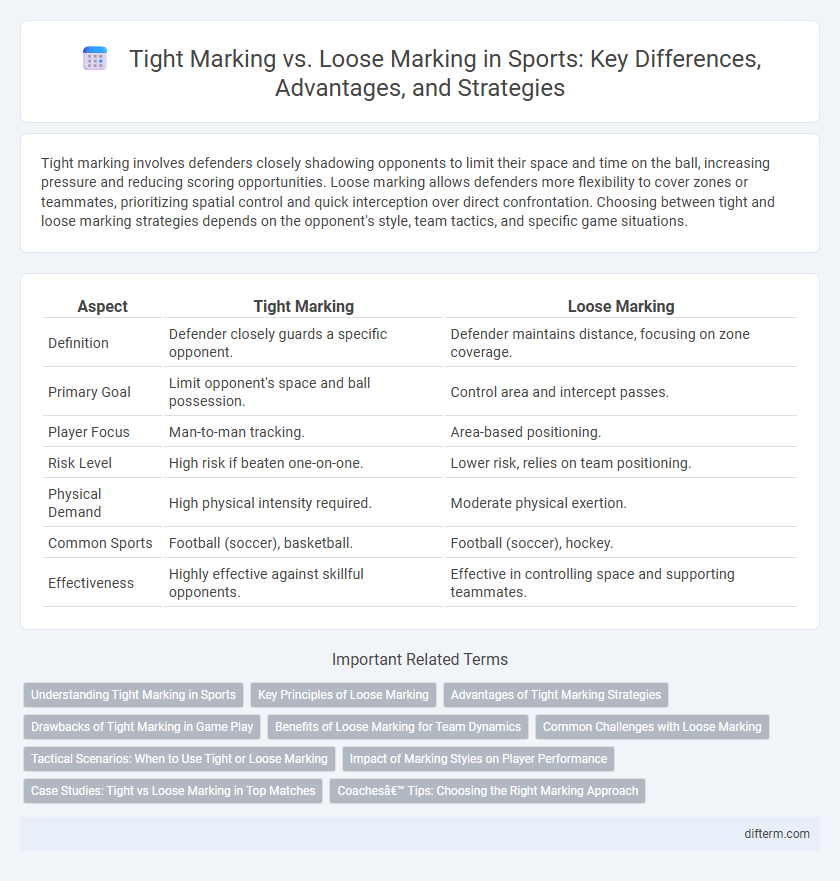Tight marking involves defenders closely shadowing opponents to limit their space and time on the ball, increasing pressure and reducing scoring opportunities. Loose marking allows defenders more flexibility to cover zones or teammates, prioritizing spatial control and quick interception over direct confrontation. Choosing between tight and loose marking strategies depends on the opponent's style, team tactics, and specific game situations.
Table of Comparison
| Aspect | Tight Marking | Loose Marking |
|---|---|---|
| Definition | Defender closely guards a specific opponent. | Defender maintains distance, focusing on zone coverage. |
| Primary Goal | Limit opponent's space and ball possession. | Control area and intercept passes. |
| Player Focus | Man-to-man tracking. | Area-based positioning. |
| Risk Level | High risk if beaten one-on-one. | Lower risk, relies on team positioning. |
| Physical Demand | High physical intensity required. | Moderate physical exertion. |
| Common Sports | Football (soccer), basketball. | Football (soccer), hockey. |
| Effectiveness | Highly effective against skillful opponents. | Effective in controlling space and supporting teammates. |
Understanding Tight Marking in Sports
Tight marking in sports involves closely guarding an opponent to restrict their movement and limit their options during play. This defensive strategy requires high levels of concentration, agility, and anticipation to effectively neutralize the opponent's influence on the game. Teams employing tight marking often disrupt the opposing team's rhythm by minimizing space and time available to key players.
Key Principles of Loose Marking
Loose marking in sports emphasizes maintaining spatial awareness and optimal positioning to cover multiple opponents effectively while conserving energy. This strategy relies on anticipating opponent movements and communicating with teammates to prevent open spaces rather than engaging in aggressive, close contact. Key principles include prioritizing zones over individual players, maintaining a flexible distance, and adapting dynamically to the flow of the game.
Advantages of Tight Marking Strategies
Tight marking strategies in sports offer increased defensive pressure, limiting opponents' space and reducing their opportunities to receive or control the ball effectively. This approach disrupts the attacking team's rhythm, forcing errors and turnovers while enabling the defending team to regain possession quickly. Enhanced player focus and communication are critical components, ensuring that tight marking maintains constant vigilance and minimizes scoring threats from key opponents.
Drawbacks of Tight Marking in Game Play
Tight marking can lead to reduced spatial awareness and increased physical fatigue for defenders, limiting their ability to cover other attacking threats effectively. It often results in fouls or disciplinary actions due to constant close contact and aggressive challenges. Teams employing tight marking risk becoming predictable and vulnerable to swift passing combinations that exploit the space left open elsewhere on the pitch.
Benefits of Loose Marking for Team Dynamics
Loose marking enhances team dynamics by promoting fluid ball movement and creating more passing options, which increases overall team cohesion and offensive versatility. It allows players to maintain spatial awareness and better anticipate opponents' movements, leading to improved team coordination and defensive coverage. This strategy fosters a collective approach where players support each other dynamically, resulting in increased adaptability and sustained pressure on the opposition.
Common Challenges with Loose Marking
Loose marking in sports often leads to increased scoring opportunities for opponents due to lack of pressure on key players. Defenders struggle with spatial awareness and timing, resulting in defensive lapses and easy ball receptions. This approach can cause team coordination issues, as inconsistent coverage leaves gaps that skilled attackers exploit effectively.
Tactical Scenarios: When to Use Tight or Loose Marking
Tight marking is crucial during defensive set-pieces or when facing a key attacker with high goal-scoring ability, limiting their space and time on the ball. Loose marking becomes effective in open play, allowing defenders to cover passing lanes and maintain team shape while preventing overloads and quick interchanges. Coaches often switch between tight and loose marking based on game tempo, player fitness, and opposition tactics to optimize defensive solidity.
Impact of Marking Styles on Player Performance
Tight marking restricts an opponent's movement and reduces their time on the ball, forcing hurried decisions and limiting playmaking ability, which often results in increased defensive success but higher physical exertion for the marker. Loose marking provides more space for the defender to anticipate plays and conserve energy, allowing greater tactical flexibility and better positioning to intercept passes, though it can give skilled opponents more freedom to maneuver. The choice between tight and loose marking directly influences player stamina, decision-making speed, and overall team defensive effectiveness.
Case Studies: Tight vs Loose Marking in Top Matches
In top football matches, tight marking has proven effective in neutralizing key playmakers, with examples like Lionel Messi being closely shadowed by defenders during El Clasico fixtures, limiting his influence. Conversely, loose marking has allowed creative players more freedom, as seen in the 2018 FIFA World Cup quarterfinals where France exploited loose marking to create scoring opportunities. Analyzing these case studies highlights that tight marking disrupts opponent rhythm, while loose marking favors teams relying on spatial control and quick ball movement.
Coaches’ Tips: Choosing the Right Marking Approach
Coaches should evaluate player strengths and opponent tactics when choosing between tight marking and loose marking to maximize defensive effectiveness. Tight marking is ideal for neutralizing key threats by limiting their space and options, while loose marking allows greater defensive flexibility and better coverage of multiple attacking players. Emphasizing communication and positional awareness helps players adapt their marking style during the game for optimal team performance.
Tight Marking vs Loose Marking Infographic

 difterm.com
difterm.com